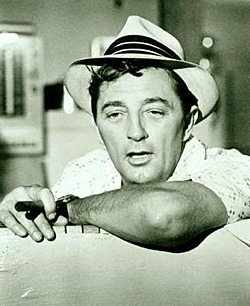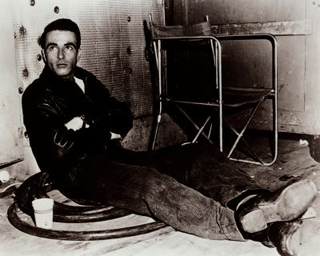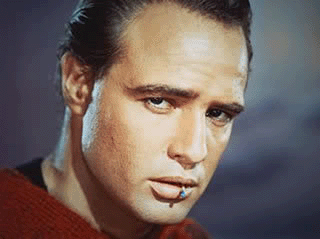|
Top 10 Most Important Leading
Hollywood Actors of All Time.
By putting together this Top 10 list of most
important leading
Hollywood actors of all time I have tried to be as objective as possible (for
instance my personal favorite actor is Robert Mitchum, who's 10th on this
list) by applying the following criteria: the importance of their specific
roles, the variety of their oeuvre, their influence on other actors (as far as
can be traced) and the directors they worked with. O.K. Here we go:
|

Cape Fear (1961)
|
10) Robert Mitchum (1917-1997)
>
Robert Mitchum
known for his apparent
laconic acting. Besides his excellent performances in the Film-noirs (Crossfire
(1947), Out of the Past (1947)) and Westerns (Man With the Gun
(1955), Rio Bravo (1959), El Dorado (1966)) of the Fifties he's
probably best known for his portrayals of the sadistic psychopaths in Charles
Laughton's Night of the Hunter (1955) and in J.L. Thompson's Cape
Fear (1961) which were both tangibly sordid performances and among his
best. Mitchum saw acting as a profession and considered being a star as a
thing of minor importance. When he turned down the leading role in Sam
Peckinpah's The Wild Bunch (1969) and instead played a comparable role
in Henry Hathaway's 5 Card Stud (1968) as he did in Night of the
Hunter, he claimed that both are Westerns.
|
|

The Untouchables (1987)
|
9) Robert de Niro (1943)
The cooperation between
Robert de Niro and his friend and director Martin Scorsese was crucial to the
success of both artists. In their first project together Mean Streets
(1973), about a group of young adolescents in New York struggling to make a
living out of loan-sharking, de Niro (who's educated in the "method
acting style") steals the show as the violent and unpredictable Johnny
Boy. Their real breakthrough came with Taxi Driver in 1976, in which
de Niro played the introverted Vietnam vet Travis Bickle, who roams the
streets in his cab, slowly transforming into a horrible avenger on the
derailed world he witnesses. De Niro won his second Oscar (The Godfather II
(1974), his first as Supporting Actor) for his role as the legendary boxer
Jake LaMotta in
Raging Bull (after persuading Scorsese to direct the film). His best
films of the Nineties are without a doubt >
Goodfellas
(1990) and Heat (1995). In the first De Niro is
perfectly cast by Scorsese as the middle-aged Irish hood of considerable
ruthlessness and repute who is Ray Liotta's mentor, Jim Conway. In Michael
Mann's masterly crime epic Heat
he plays the master criminal Neil McGauley cast opposite (for the first time
in a film together) to the other movie icon Al Pacino as his cop nemisis. In
Quentin Tarantino's Jackie Brown (1997)
De Niro underplayed, that way
giving his colleagues more space to excel.
|
|

Studio photo
|
8) Burt Lancaster (1913-1994)
Burt Lancaster's film career started in the
Forties in the stifling melodrama's of Robert Siodmark (The Killers
(1946), Criss Cross (1949). After some "light" films in the
early Fifties he returned to the genre of Film-noir in the dark film Sweet
Smell of Success (1957) in which he played the cynical and powerful
columnist J.J. Hunsecker who destroys his sister's relationship with her
boyfriend. Also memorable is his role in Birdman of Alcatraz (1962) and
his Oscar winning performance in Elmer Gantry (1960). Lancaster also
build an impressive career in Europe where he worked with the Italian
directors Luchino Visconti (The Leopard and The Conversation Piece)
and Bernardo Bertolucci (1900). His last important role was in Louis
Malle's masterpiece > Atlantic City U.S.A. (1980)
|
|

Studio photo
|
7) James Stewart (1908-1997)
James Stewart, the long thin man with his
famous drawling voice has been an important leading actor for thirty years and
a modest and beloved star. His first striking performance was in Mr Smith
Goes to Washington (1939) by Frank Capra in which he played a gangly, shy
and idealistic senator who exposes corruption. The Fifties has been his most
decisive period of his acting career. His startling performances in Anthony
Mann's Westerns (they made 5 together) in which he mainly personified grim and
cynical men (The Naked Spur (1953) and especially The Man From
Laramie (1955)) are diametrically opposite to most of his work before and
after this series of films. Stewart made four films with the suspense maestro >
Alfred
Hitchcock.
The two finest (for probably both the actor and director) are the
magnificently staged Rear Window (1954), with Stewart as the
immobilised photographer who has a broken leg and witnesses a murder while
looking through his binoculars and the enigmatic and bleak mystery Vertigo
(1958) in which he portrayed a neurotic detective who falls in love with his
friend's wandering wife whom he has to trail. The old Hollywood star brought a
level of neurotic energy to his best roles that few Method actors could match.
|
|

On the set
|
6) Montgomery Clift (1920-1966)
"He's a little queer, don't you think
so?" John Wayne remarked to his secretary after meeting >
Montgomery
Clift his co-star in Red River
(1948). Later, when the film was finished he was won over by the great
professionalism of the young "method" actor. When Clift was 15 he
already played small professional roles. With his slender stature, thin face
and expressive eyes he soon became a romantic hero, especially when persistent
rumors arose about a relationship with Elizabeth Taylor. With her he
co-starred in three films (A Place in the Sun (1951), Raintree
Country (1957) and Suddenly, Last Summer (1959) and they remained
friends for the rest of his life. In the Fifties Clift was the most sought
after actor but he was very reluctant and critical on the roles he chose.
During the production of Raintree Countree Clift had a terrible car
accident, which damaged him both physically and emotionally. His life after
that has been described as the longest suicide in the history of Hollywood
(alcohol and drug addiction). Despite of his addiction he continued acting and
had some memorable and heartbreaking performances in Judgment at Nuremberg
(1961) and The Misfits (1961). He was nominated for an Academy award
four times and died from an heart attack at the young age of 46 years old.
|
|

Grapes of Wrath (1940)
|
5) Henry Fonda (1905-1982)
Henry Fonda embodied integrity on the screen
(and also in his personal life). Almost all the characters he portrayed
breathed dignity, from the young farmer leading his family in >
John Ford's
Grapes
of Wrath (1940), the drifter Gil carter defending a convict against an
excited mob in William Wellman's >
The Oxbow Incident (1943), Wyatt Earp in My
Darling Clementine (1946), the musician Manny Balestrero wrongfully
accused of murder in Alfred Hitchock's The Wrong Man (1957) and Juror
#8 in Twelve Angry Men (1957). In Once Upon a Time in the West
(1968) he proofed he also could play a depraved and unscrupulous villain. The
only "flaw" in his magnificent acting career is that he very
seldomly appeared in comedies while he was known as a humorous man in his
personal life. For his portrayal of the grubby retired professor Norman Thayer
Jr. in On Golden Pond (1981) he finally won an Oscar.
|
|

Rebel Without a Cause (1955)
|
4) James Dean (1931-1955)
Countless books have been published and films
have been released on James Dean, its subjects varying from the man behind the
legend, his sexual preferences, his so-called death wish and his role as a
symbol of the disillusioned youth. With a legacy of only three films, Dean
played characters who embodied loneliness, frustration and anger to whom a
young audience (the post war generation) could identify. He was educated in
the > Method Acting
style,
like his idol Marlon Brando, and because of his troubled youth (his mother, of
whom he was very fond, died when he was 9) he could empathize with his
characters very easily. As Dean proofed in his roles as Cal Trask in Elia
Kazan's East of Eden (1955) in the emotionally charged scenes when he
tries to win his father's (Raymond Massey) respect or as the misunderstood
adolescent Jim Stark in Nicolas Ray's Rebel Without a Cause (1955) who
forms a 'surrogate family'. In his final role (before his tragic car accident)
as Jett Rink in George Steven's epic melodrama Giant (1956) he also
showed his capability to play middle-aged men.
|
|

High Sierra (1941)
|
3) Humphrey Bogart (1899-1957)
Humphrey Bogart who would become a legend with
his roles as the snarling and sardonic P.I.'s Phillip Marlowe and Sam Spade
started his acting career in the Twenties on Broadway. He had a breakthrough
with his performance in the film The Petrified Forest (he already
played in the stage version the year before) in 1936, as the savaged Duke
Mantee (inspired by John Dillinger). In the Forties he became one of the most
dominating actors in Hollywood with excellent performances in High Sierra (1941),
The Maltese Falcon (1941), Casablanca (1942), The Big Sleep
(1946), Key Largo (1948), The Treasure of Sierra Madre (1948)
and The African Queen (1951). The characters Bogart played late in his
career, like Dead Reckoning (1947),
> In a Lonely Place (1950)
and The
Harder They Fall (1956) were embittered, self-loathing types, and are his
most daring and original work.
|
|

Studio photo
|
2) James Cagney (1899-1986)
The thesis that a film role has to be a
projection of the personality of the actor is especially applicable on James
Cagney. His ability to portray heroes, sympathetic villains and psychotic
egoļsts with an electrifying energy, is unmatched in the history of cinema.
His first leading role in William Wellman's The Public Enemy (1931) as
the gangster Tom Powers made him an instant star. In the following years he
continued playing gangsters (Angels With Dirty Faces (1938),
> Roaring
Twenties (1939) for
the Warner Brothers studio who were known for their gritty and realistic
pictures. In 1942 Cagney won the Oscar for Best Actor for his role in the
musical Yankee Doodle Dandy which showed his diversity. After the
comedy One, Two, Three in 1961 he retreated only to return one more
time in the film Ragtime (1981) as the authoritative police chief
Waldo.
|
|

One-Eyed Jack's (1961)
|
1) Marlon
Brando (1924-2004)
What's so striking about Marlon
Brando's impressive career is that he also performed in a lot of superfluous
films. The actor, who would heavily influence actors like James Dean, Robert
de Niro, Jack Nicholson, Paul Newman and many others, derived his acting
method from the Stanislawski system. Brando was one of the first members of >
The
Actors Studio founded by Lee Strasberg and Elia Kazan. With Kazan he made the
groundbreaking Streetcar Named Desire (1951), playing the charismatic
but violent Ed Kowalski (nominated for the Academy Award for Best Actor) whom
he already had portrayed in the Broadway version based on the eponymous book
of Tenessee Williams. In the following years his roles in Viva Zapata!
(1952), Julius Caesar (1953) and >
On the Waterfront (1954) were all nominated for the Academy Award for Best Actor (8 times in his
whole career) with the latter awarded. In 1961 he directed and played in the
eccentric Western One-Eyed Jack's, after Stanley Kubrick retreated from
the project, together with his life-time friend Karl Malden. In the Seventies
he returned with iconic performances in The Godfather (1972), Last
Tango in Paris (1972) and Apocalypse Now (1976). After these films
Brando's appearances were short, expensive and permeated by self-deprecation.
His last important role was in A Dry White Season (1989), in which he
portrayed a human rights attorney who fights against the Apartheid system in
South-Africa.
|
More Top 10 lists and articles can be found on
the following page: >
Articles on Film
|
|
|